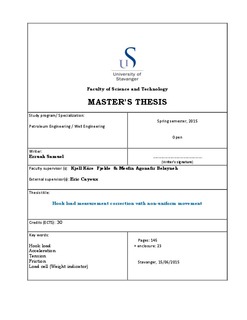| dc.description.abstract | In the recent years, oil and gas exploration and production are being carried out in extremely harsh and challenging environmental conditions. Hence, accurate prediction of the hook load is essential in order to minimise the Non- Productive Time (NPT) during the drilling operation stages. With accurate prediction of hook load, undesirable drilling problems such as buckling, stuck pipe, tensile failure can be minimised if not completely eradicated.
There are numerous factors affecting the hook load prediction such as, the weight per unit length (W/l) of the drill pipe used, the density of the drilling mud used, the friction in the well, the weight per unit length (W/l) of the drilling line used, just to mention but a few. These above factors will not be discussed in-depth in this thesis but rather this thesis aims at developing a mathematical model to incorporate into the existing models, the effect of acceleration on hook load prediction.
There are numerous hook load prediction models in the oil and gas industry such as the industry accepted hook load prediction model, the Luke and Juvkam-Wold hook load prediction model and the Cayeux et al hook load prediction model. The rationale behind this thesis is to understand these existing hook load prediction models and further develop them by incorporating the effect of acceleration. These existing models gives a good prediction of the hook load measurements but the accuracy can be improved by taking into account that the efficiency of each sheave might not be same and also taking into consideration the effect of acceleration. The extended models will be analysed using hypothetical data.
After analysing the extended models using the hypothetical data, it was discovered that during non-uniform movement of the travelling equipment the sum of the tensions in the supporting lines are not the same as the hook load (W). Hence, the position for the load cell placement is very essential to ensure accurate hook load measurement.
During hoisting with non-uniform movement of the travelling equipment, the sum of the tensions in the supporting lines always exceeds the hook load (W) value with the discrepancy between them being influenced by the acceleration (a) of the travelling equipment.
Hence, the minimum expected hook load (W) value during hoisting is during non-uniform movement of the travelling equipment with high a/g ratio and vice-versa.
During lowering with non-uniform movement of the travelling equipment, the hook load (W) measurement always exceeds the sum of the tensions in the supporting lines with the disparity between them also influenced by the acceleration (a) of the travelling equipment.
Hence, the maximum hook load (W) measurement during lowering occurs when the travelling equipment is undergoing non-uniform movement with high a/g ratio and vice-versa.
Finally, it was observed that even though the dead line is non-rotating, its efficiency is not perfect(e_dl≠1). The efficiency of each sheave from the extended Cayeux et al hook load prediction model was used as an input for the extended Luke and Juvkam model. It was observed that the extended Cayeux et al hook load prediction model (which served as the experimental data) produces approximately the same results as the rotating (Active) dead line sheave hook load prediction model but deviates from the non-rotating (inactive) dead line sheave counterpart. The degree of the deviation depends on the coefficient of friction (the efficiency of each sheave). Hence, it can be inferred that the dead line sheave is not perfect. This can be confirmed with experimental data. | nb_NO |
